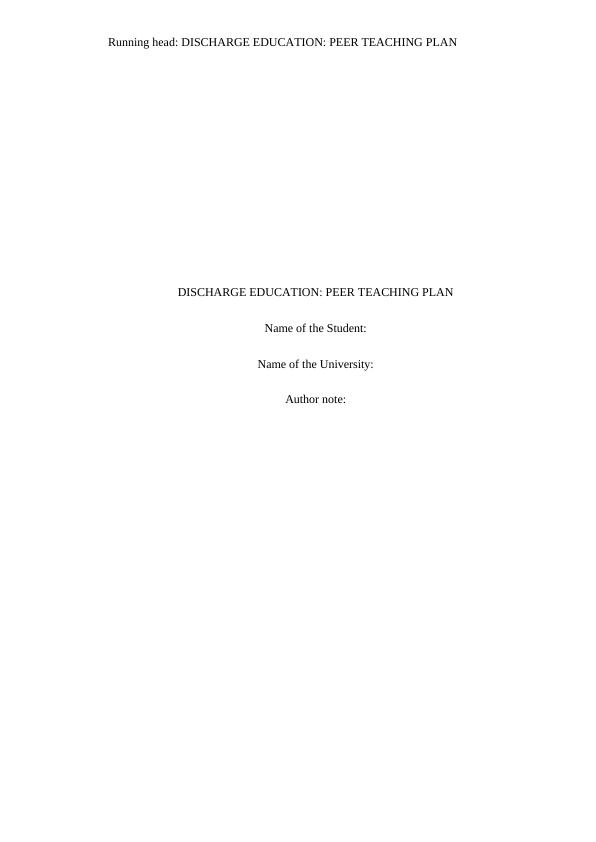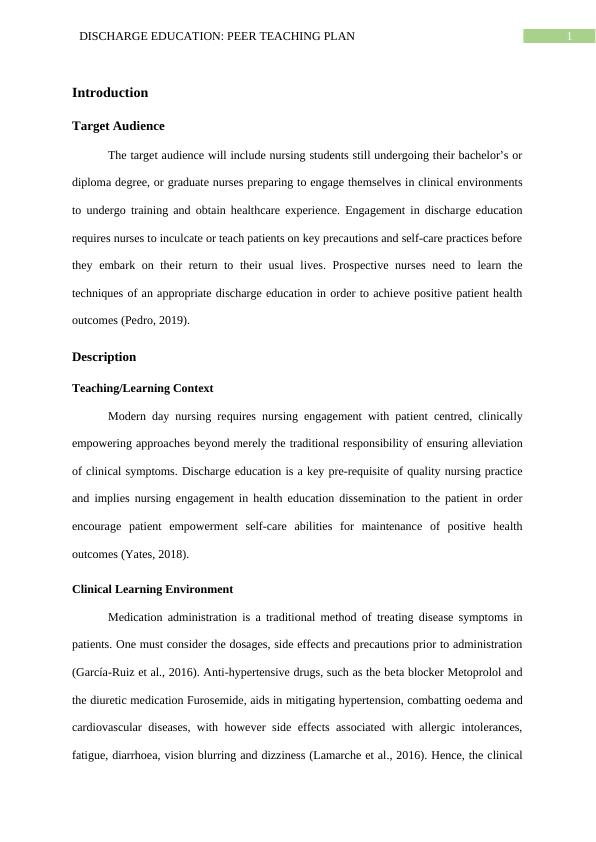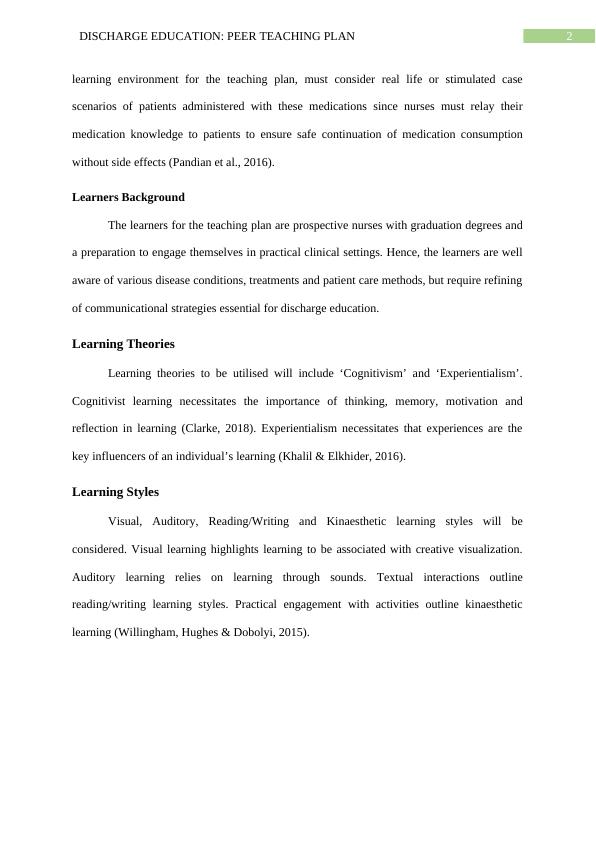Discharge Education: Peer Teaching Plan
Added on 2023-06-12
10 Pages2294 Words120 Views
Running head: DISCHARGE EDUCATION: PEER TEACHING PLAN
DISCHARGE EDUCATION: PEER TEACHING PLAN
Name of the Student:
Name of the University:
Author note:
DISCHARGE EDUCATION: PEER TEACHING PLAN
Name of the Student:
Name of the University:
Author note:

1DISCHARGE EDUCATION: PEER TEACHING PLAN
Introduction
Target Audience
The target audience will include nursing students still undergoing their bachelor’s or
diploma degree, or graduate nurses preparing to engage themselves in clinical environments
to undergo training and obtain healthcare experience. Engagement in discharge education
requires nurses to inculcate or teach patients on key precautions and self-care practices before
they embark on their return to their usual lives. Prospective nurses need to learn the
techniques of an appropriate discharge education in order to achieve positive patient health
outcomes (Pedro, 2019).
Description
Teaching/Learning Context
Modern day nursing requires nursing engagement with patient centred, clinically
empowering approaches beyond merely the traditional responsibility of ensuring alleviation
of clinical symptoms. Discharge education is a key pre-requisite of quality nursing practice
and implies nursing engagement in health education dissemination to the patient in order
encourage patient empowerment self-care abilities for maintenance of positive health
outcomes (Yates, 2018).
Clinical Learning Environment
Medication administration is a traditional method of treating disease symptoms in
patients. One must consider the dosages, side effects and precautions prior to administration
(García-Ruiz et al., 2016). Anti-hypertensive drugs, such as the beta blocker Metoprolol and
the diuretic medication Furosemide, aids in mitigating hypertension, combatting oedema and
cardiovascular diseases, with however side effects associated with allergic intolerances,
fatigue, diarrhoea, vision blurring and dizziness (Lamarche et al., 2016). Hence, the clinical
Introduction
Target Audience
The target audience will include nursing students still undergoing their bachelor’s or
diploma degree, or graduate nurses preparing to engage themselves in clinical environments
to undergo training and obtain healthcare experience. Engagement in discharge education
requires nurses to inculcate or teach patients on key precautions and self-care practices before
they embark on their return to their usual lives. Prospective nurses need to learn the
techniques of an appropriate discharge education in order to achieve positive patient health
outcomes (Pedro, 2019).
Description
Teaching/Learning Context
Modern day nursing requires nursing engagement with patient centred, clinically
empowering approaches beyond merely the traditional responsibility of ensuring alleviation
of clinical symptoms. Discharge education is a key pre-requisite of quality nursing practice
and implies nursing engagement in health education dissemination to the patient in order
encourage patient empowerment self-care abilities for maintenance of positive health
outcomes (Yates, 2018).
Clinical Learning Environment
Medication administration is a traditional method of treating disease symptoms in
patients. One must consider the dosages, side effects and precautions prior to administration
(García-Ruiz et al., 2016). Anti-hypertensive drugs, such as the beta blocker Metoprolol and
the diuretic medication Furosemide, aids in mitigating hypertension, combatting oedema and
cardiovascular diseases, with however side effects associated with allergic intolerances,
fatigue, diarrhoea, vision blurring and dizziness (Lamarche et al., 2016). Hence, the clinical

2DISCHARGE EDUCATION: PEER TEACHING PLAN
learning environment for the teaching plan, must consider real life or stimulated case
scenarios of patients administered with these medications since nurses must relay their
medication knowledge to patients to ensure safe continuation of medication consumption
without side effects (Pandian et al., 2016).
Learners Background
The learners for the teaching plan are prospective nurses with graduation degrees and
a preparation to engage themselves in practical clinical settings. Hence, the learners are well
aware of various disease conditions, treatments and patient care methods, but require refining
of communicational strategies essential for discharge education.
Learning Theories
Learning theories to be utilised will include ‘Cognitivism’ and ‘Experientialism’.
Cognitivist learning necessitates the importance of thinking, memory, motivation and
reflection in learning (Clarke, 2018). Experientialism necessitates that experiences are the
key influencers of an individual’s learning (Khalil & Elkhider, 2016).
Learning Styles
Visual, Auditory, Reading/Writing and Kinaesthetic learning styles will be
considered. Visual learning highlights learning to be associated with creative visualization.
Auditory learning relies on learning through sounds. Textual interactions outline
reading/writing learning styles. Practical engagement with activities outline kinaesthetic
learning (Willingham, Hughes & Dobolyi, 2015).
learning environment for the teaching plan, must consider real life or stimulated case
scenarios of patients administered with these medications since nurses must relay their
medication knowledge to patients to ensure safe continuation of medication consumption
without side effects (Pandian et al., 2016).
Learners Background
The learners for the teaching plan are prospective nurses with graduation degrees and
a preparation to engage themselves in practical clinical settings. Hence, the learners are well
aware of various disease conditions, treatments and patient care methods, but require refining
of communicational strategies essential for discharge education.
Learning Theories
Learning theories to be utilised will include ‘Cognitivism’ and ‘Experientialism’.
Cognitivist learning necessitates the importance of thinking, memory, motivation and
reflection in learning (Clarke, 2018). Experientialism necessitates that experiences are the
key influencers of an individual’s learning (Khalil & Elkhider, 2016).
Learning Styles
Visual, Auditory, Reading/Writing and Kinaesthetic learning styles will be
considered. Visual learning highlights learning to be associated with creative visualization.
Auditory learning relies on learning through sounds. Textual interactions outline
reading/writing learning styles. Practical engagement with activities outline kinaesthetic
learning (Willingham, Hughes & Dobolyi, 2015).

End of preview
Want to access all the pages? Upload your documents or become a member.
Related Documents
Teaching Plan for Asthma Spacer Guidelinelg...
|9
|1598
|265
LEADERSHIP FOR CLINICAL PRACTICElg...
|8
|1744
|17
Diabetic Foot Care And Prevention of Foot Injurylg...
|9
|1762
|18
Clinical Teaching Plan for Alzheimer's Disease: Symptoms, Diagnosis, and Treatmentlg...
|13
|3335
|92
Nursing | Assignment | Newlg...
|8
|1904
|17
Teaching Plan for Clinical Education on Type 2 Diabetes Mellituslg...
|14
|3480
|137